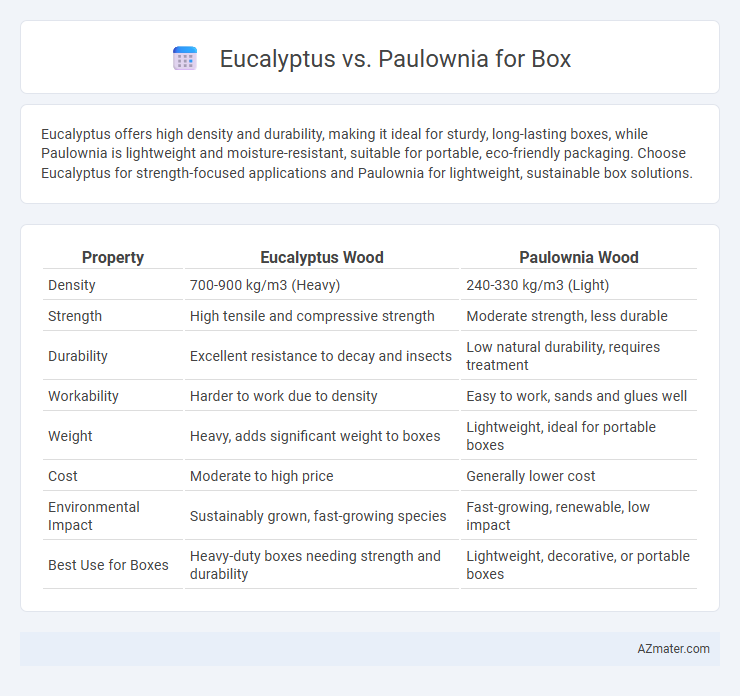Eucalyptus offers high density and durability, making it ideal for sturdy, long-lasting boxes, while Paulownia is lightweight and moisture-resistant, suitable for portable, eco-friendly packaging. Choose Eucalyptus for strength-focused applications and Paulownia for lightweight, sustainable box solutions.
Table of Comparison
| Property | Eucalyptus Wood | Paulownia Wood |
|---|---|---|
| Density | 700-900 kg/m3 (Heavy) | 240-330 kg/m3 (Light) |
| Strength | High tensile and compressive strength | Moderate strength, less durable |
| Durability | Excellent resistance to decay and insects | Low natural durability, requires treatment |
| Workability | Harder to work due to density | Easy to work, sands and glues well |
| Weight | Heavy, adds significant weight to boxes | Lightweight, ideal for portable boxes |
| Cost | Moderate to high price | Generally lower cost |
| Environmental Impact | Sustainably grown, fast-growing species | Fast-growing, renewable, low impact |
| Best Use for Boxes | Heavy-duty boxes needing strength and durability | Lightweight, decorative, or portable boxes |
Introduction: Eucalyptus vs Paulownia for Box Manufacturing
Eucalyptus and Paulownia are popular wood choices for box manufacturing due to their distinct properties. Eucalyptus offers high density, durability, and resistance to moisture, making it ideal for heavy-duty shipping boxes. Paulownia is lightweight, fast-growing, and easy to work with, providing eco-friendly options for lightweight and decorative packaging boxes.
Botanical and Growth Characteristics
Eucalyptus species, known for their rapid growth and adaptability to diverse climates, feature tall, straight trunks with aromatic leaves rich in essential oils, making them ideal for timber and pulp production. Paulownia trees are renowned for their exceptionally fast growth rates and large, broad leaves, which contribute to high biomass accumulation and efficient carbon sequestration in lightweight, fine-grained wood. Both genera exhibit distinct botanical traits: Eucalyptus has lance-shaped, volatile oil-containing leaves, while Paulownia displays heart-shaped foliage, with growth cycles favoring quick establishment and high yield in timber box manufacturing.
Wood Density and Strength Comparison
Eucalyptus wood is known for its high density, typically ranging from 600 to 900 kg/m3, which contributes to its impressive strength and durability for box manufacturing. Paulownia, with a significantly lower density of around 270 to 350 kg/m3, offers a lightweight alternative but with less structural strength compared to eucalyptus. The superior density and hardness of eucalyptus make it more suitable for applications requiring robust, impact-resistant boxes, whereas paulownia excels where weight reduction and ease of handling are prioritized.
Durability and Longevity in Box Applications
Eucalyptus wood offers high durability and resistance to decay, making it a popular choice for long-lasting box applications exposed to moisture. Paulownia, lighter and less dense than eucalyptus, provides moderate durability but is prone to dents and scratches, limiting its longevity in heavy-use or outdoor boxes. For optimal box durability and lifespan, especially in demanding environments, eucalyptus outperforms paulownia due to its superior hardness and natural resistance to pests and weathering.
Workability and Machining Properties
Eucalyptus wood, known for its density and hardness, offers good workability but can be challenging to machine due to its interlocked grain and occasional gum deposits, requiring sharp tools and careful handling to avoid tear-out. Paulownia, much lighter and softer, excels in machining properties with smooth cutting and minimal tool wear, making it ideal for intricate box construction where precision is critical. Both woods finish well, but Paulownia's ease of shaping and sanding often makes it preferred for detailed box designs, while Eucalyptus provides greater durability and strength.
Sustainability and Environmental Impact
Eucalyptus and Paulownia are both fast-growing trees used in box production, but Paulownia offers superior sustainability due to its exceptional carbon sequestration and low water requirements. Eucalyptus, while efficient in timber yield, often demands more water and can lead to soil depletion or biodiversity loss if not managed responsibly. Choosing Paulownia supports eco-friendly packaging by minimizing environmental impact and promoting reforestation with minimal resource consumption.
Cost and Market Availability Analysis
Eucalyptus offers a lower-cost option due to its fast growth rate and widespread plantation, making it more accessible for box manufacturing at scale. Paulownia commands a higher price point driven by its lightweight properties and limited regional cultivation, which narrows market availability. Cost-efficient eucalyptus wood dominates bulk supply chains, whereas Paulownia is preferred for premium or specialized box applications where market demand supports higher pricing.
Aesthetic Qualities: Grain, Color, and Texture
Eucalyptus wood features a tight, interlocked grain with a rich golden to reddish-brown hue that darkens with age, offering a warm and rustic aesthetic ideal for boxes seeking a traditional look. Paulownia exhibits a lighter, pale cream to light brown color with a straight, uniform grain and a smooth texture that provides a clean, modern appearance often preferred for minimalist or decorative boxes. The contrasting grain patterns and color tones between Eucalyptus and Paulownia allow box makers to select materials that align with specific design aesthetics, durability requirements, and desired finishes.
Common Box Uses: Eucalyptus vs Paulownia
Eucalyptus wood is highly favored for box construction due to its durability, insect resistance, and dense grain, making it ideal for heavy-duty crates and pallets. Paulownia, in contrast, offers lightweight properties and rapid growth, resulting in boxes that are easier to handle and environmentally sustainable but less robust. Common box uses see Eucalyptus preferred for industrial storage and shipping, while Paulownia suits lightweight packaging and decorative or specialty boxes.
Conclusion: Choosing the Right Wood for Box Making
Paulownia wood offers superior lightweight strength and faster growth rates, making it ideal for eco-friendly, durable boxes that require easy handling and shipping. Eucalyptus provides higher density and natural resistance to moisture and pests, suitable for boxes demanding robust protection in harsh environments. Selecting the right wood depends on prioritizing weight efficiency and sustainability with Paulownia, or enhanced durability and moisture resistance with Eucalyptus in box manufacturing.

Infographic: Eucalyptus vs Paulownia for Box
 azmater.com
azmater.com